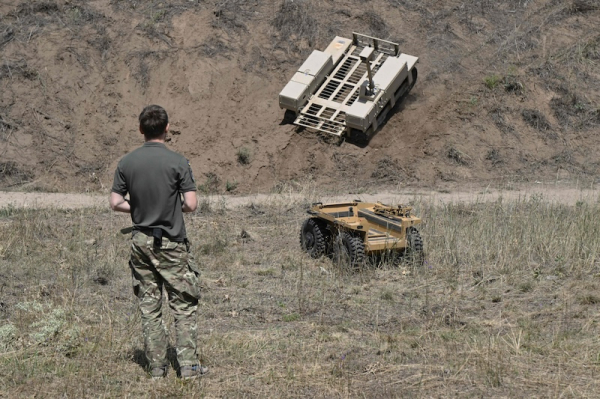Finland moves to buy demining robots amid rising demand for combat machines

Ukrainian serviceman from the 93rd Separate Mechanized Brigade controls unmanned ground vehicles on a training ground at an undisclosed location in eastern Ukraine. Photo: Genya Savilov / AFP / Lehtikuva
- Next Article Finland backs clean energy shift at Busan summit
Finland is seeking new unmanned ground vehicles (UGVs) to support its explosive ordnance disposal teams, joining a growing list of European countries investing in battlefield robotics.
The Finnish Defence Forces issued a €14.3 million tender to procure two types of military robots, one large and one small, for domestic and international use in clearing mines and improvised explosive devices.
According to the logistics command, the systems will support all standard explosive ordnance disposal (EOD) and improvised explosive device disposal (IEDD) operations. The robots must be suited to Finnish terrain and adaptable for use in crisis response missions abroad.
The plan includes an initial purchase of four platforms, with spare parts and training. The contract allows for an expansion to eight units.
Each robot must weigh less than 300 kilograms and use tracked movement. The systems must operate wirelessly and be equipped with at least two disruptors for disabling explosives. Human operators must be able to activate the disruptors via a remote interface.
The call for tenders follows a wider shift in European defence planning, with robotic ground systems gaining traction after initial caution. The technology has advanced through conflict-driven testing, particularly in Ukraine.
Ukraine has played a leading role in the development of UGVs, having formed the world’s first dedicated UGV battalion. The conflict has accelerated real-world testing and exposed gaps in traditional defence systems.
In July 2023, the Estonian Defence Forces organised a vendor demonstration focused on unmanned ground systems. At the time, organisers told the news agency Defence News that while the systems showed promise, they needed significant robustness improvements before they could be deployed in complex operational theatres like Ukraine.
Since then, contracts for UGVs have expanded across Europe and beyond. Estonian firm Milrem Robotics, now owned by the UAE’s Edge Group, has supplied its THeMIS platform to Ukraine and other countries. The firm’s UGVs have also been ordered by the militaries of Japan and the United Arab Emirates.
In June this year, Rheinmetall Defense Nederland signed an agreement with the Dutch Ministry of Defence to deliver 20 UGVs to Ukraine as part of the Ukraine Task Force.
France is currently trialling the Aurochs 4×4 UGV with the aim of fielding combat-capable robotic systems by 2040.
In July, Italy hosted an operational testing event supported by the European Defence Agency. Six European defence firms participated, showcasing the capabilities of both aerial and ground-based unmanned systems.
The increasing adoption of robotic systems marks a shift in European military thinking. Unmanned platforms are no longer treated as optional enhancements but are now seen as central to the future structure of land forces.
HT
- Next Article Finland backs clean energy shift at Busan summit
Source: www.helsinkitimes.fi
